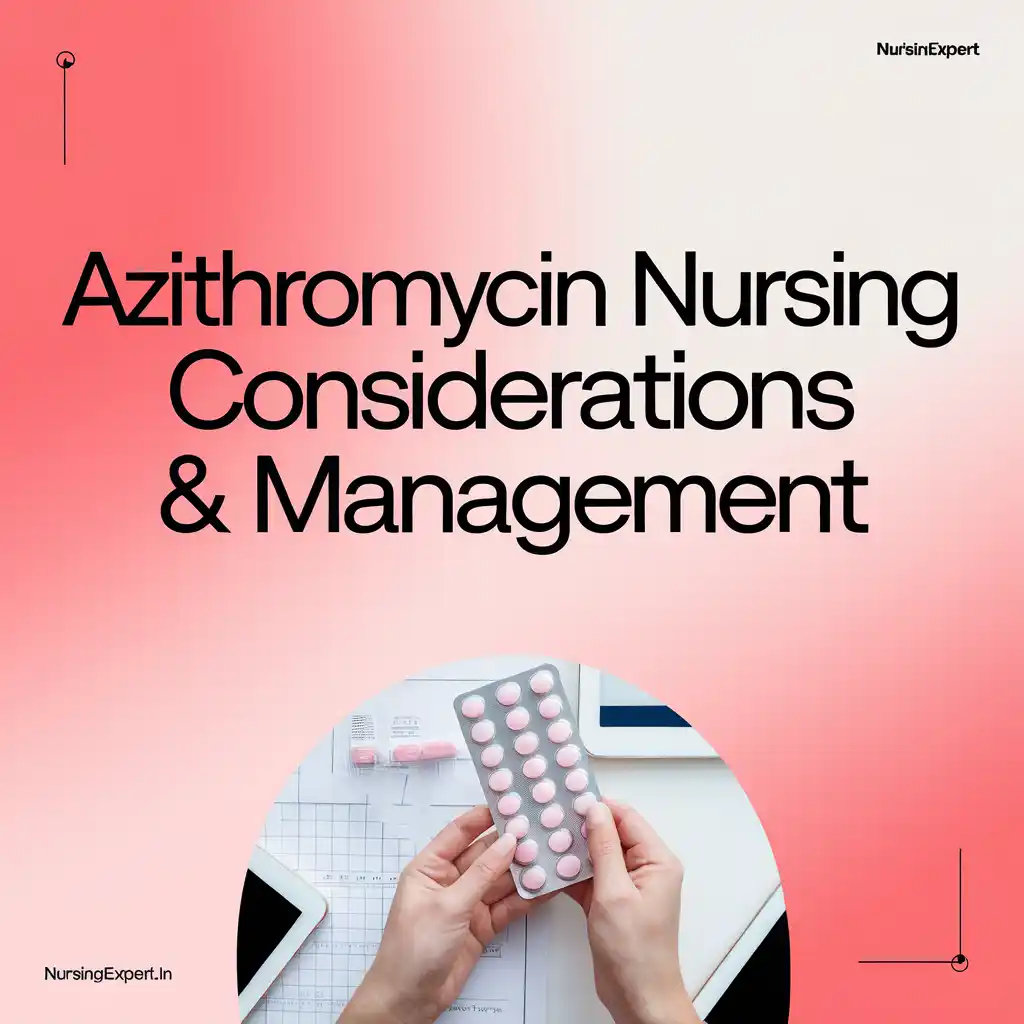Azithromycin is a macrolide antibiotic widely used to treat various bacterial infections, such as respiratory tract infections, skin infections, and sexually transmitted infections. Its long half-life and once-daily dosing enhance patient compliance, making it a valuable tool in outpatient settings. Nurses play a critical role in its administration, monitoring, and patient education to ensure safe and effective treatment. This article outlines key nursing considerations and management strategies for azithromycin, providing practical guidance for optimizing patient outcomes.
Thank you for reading this post, don't forget to subscribe!
Introduction to Azithromycin
Azithromycin belongs to the macrolide class of antibiotics and works by inhibiting bacterial protein synthesis through binding to the 50S ribosomal subunit. It is effective against a broad spectrum of Gram-positive, Gram-negative, and atypical bacteria, including Mycoplasma pneumoniae and Chlamydia trachomatis. With a half-life of approximately 68 hours, azithromycin allows for once-daily dosing and shorter treatment durations (e.g., 3-5 days), distinguishing it from other antibiotics. Nurses must understand its pharmacokinetics, indications, and potential risks to manage its use effectively.


Nursing Considerations
Pharmacokinetics
- Absorption: Azithromycin is well-absorbed orally and can be taken with or without food, though food may reduce gastrointestinal upset.
- Distribution: It concentrates in tissues, especially the lungs, making it ideal for respiratory infections.
- Elimination: Primarily metabolized by the liver, with minimal renal excretion; no dose adjustment is typically needed for renal impairment, but caution is required in hepatic dysfunction.
Indications
Azithromycin is commonly prescribed for:
- Respiratory tract infections (e.g., pneumonia, bronchitis)
- Skin and soft tissue infections
- Sexually transmitted infections (e.g., chlamydia, gonorrhea)
- Otitis media
- Mycobacterial infections
Note: It is ineffective against viral infections like the common cold or flu and should not be used for these conditions.
Contraindications and Precautions
- QT Prolongation: May increase the risk of arrhythmias (e.g., torsades de pointes). Use cautiously in patients with:
- History of arrhythmias
- Congenital long QT syndrome
- Use of other QT-prolonging drugs (e.g., amiodarone)
- Hepatic Dysfunction: Risk of hepatotoxicity requires liver function monitoring in patients with liver disease.
- Myasthenia Gravis: May worsen muscle weakness.
- Hypersensitivity: Contraindicated in patients allergic to macrolides.
Side Effects
- Common:
- Gastrointestinal: Nausea, vomiting, diarrhea, abdominal pain
- Neurological: Headache, dizziness
- Allergic: Rash, itching
- Serious:
- Cardiac: QT prolongation, arrhythmias
- Hepatic: Hepatitis, jaundice
- Clostridioides difficile-associated diarrhea (CDAD)
Nursing Actions:
- Monitor for gastrointestinal distress and provide supportive care (e.g., hydration).
- Watch for allergic reactions and report severe symptoms (e.g., anaphylaxis) immediately.
- Assess for signs of arrhythmias (e.g., palpitations, fainting).
Administration
- Oral: Taken once daily, with or without food. Food may lessen stomach upset.
- Intravenous (IV): Infuse 500 mg over 60 minutes, ensuring proper dilution and compatibility with other IV drugs.
- Dosing Example: 500 mg on day 1, then 250 mg daily for 4 days (Z-Pak), per provider orders.
Nursing Tip: Check IV site for phlebitis or extravasation during infusion.
Drug Interactions
- Antacids: Reduce absorption; take 2 hours apart from azithromycin.
- Warfarin: Increases bleeding risk; monitor INR.
- Digoxin: Elevates digoxin levels; watch for toxicity (e.g., nausea, arrhythmias).
- Statins: Heightens risk of myopathy with drugs like simvastatin.
Nursing Actions:
- Review medication lists for interactions.
- Consult the healthcare provider or pharmacist as needed.
Patient Education
- Adherence: Complete the full course to prevent antibiotic resistance, even if symptoms resolve.
- Side Effects: Expect possible nausea or diarrhea; report severe symptoms (e.g., rash, irregular heartbeat).
- Administration: Take at the same time daily; use a measuring device for liquids.
- Prevention: Practice good hygiene (e.g., handwashing) to limit infection spread.
- When to Seek Help: Contact a provider for allergic reactions, severe diarrhea, or heart rhythm changes.
Example Teaching:
“Take this once a day, finish all the pills even if you feel better, and let us know if you get a rash or feel your heart racing.”
Conclusion
Azithromycin is an effective antibiotic when managed properly. Nurses must consider its pharmacokinetics, monitor for side effects and interactions, and educate patients to ensure adherence and safety. By applying these principles, nurses can support successful treatment and minimize complications.
Disclaimer: This article is for educational purposes only. Consult a healthcare provider for patient-specific advice.


